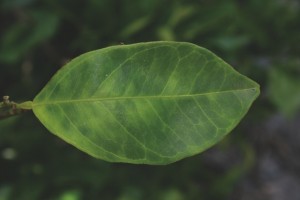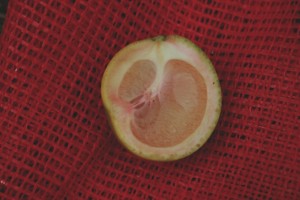Tangerines, oranges, lemons, limes, pummelo and grapefruit— sharing a box of citrus just picked from the backyard is part of life in Hawai‘i, much as leaving your slippers outside the front door.
But imagine walking outside to find your trees covered in bitter, misshapen fruit: no more fresh lemons, tangerines, or oranges from your yard. Backyard gardeners and commercial growers across the mainland are scrambling to protect their citrus in the face of one of the most serious citrus diseases in the world, a disease perched on Hawai‘i’s doorstep.
Citrus greening disease, also known as huanglongbing or yellow dragon disease, originated in Asia. It was first detected in the United States in Florida in August of 2005. By July of 2008 it had spread across the state. It has since sprung up in backyards and farms throughout the Southern United States. Once infected, plants don’t recover and thousands of trees throughout the Southeast have died. The impacts to the citrus industry in Florida have been profound. California citrus growers are bracing themselves after the disease popped up in a Los Angeles suburb last summer.
A tiny, gnat-sized insect, the Asian citrus psyllid (Diaphorina citri), is responsible for spreading citrus greening disease. These psyllids feed on the stems and leaves of citrus and must feed on an infected tree to spread the bacterial disease. Currently, citrus greening is not present in Hawai‘i, but we do have sizeable populations of non-native Asian psyllid. Across the mainland the trend has been for the arrival of the psyllid to be followed by the disease.
The Asian citrus psyllid was first detected on the Big Island in 2006. Monica Tauyan is a plant pest

The pattern of “blotchy mottle” on this citrus leaf is an classic sign of a citrus greening infection. Photo courtesy of the University of Florida Institute of Food and Agricultural Sciences-Citrus Canker.
control technician with the Hawai‘i Department of Agriculture. She is part of a team that regularly surveys citrus across the state for citrus greening. Tauyan has no problem finding the Asian psyllid living on a variety of different citrus. “The psyllid causes leaf curl,” she says, “but the major concern is the disease.” If citrus greening arrives, the psyllids will carry the disease from tree to tree. Tauyan conducts surveys on Maui several times a year, and on Moloka‘i and Lāna‘i annually. Her efforts have been focused on farms, nurseries, and residences, and to date, have come up empty handed.
She’s looking for blotchy mottling on the leaves in an asymmetric pattern, “It’s the classic symptom.” according to Tauyan. When she finds this, or other indicators—such as yellowing leaves or misshapen, bitter fruit that don’t ripen—she collects samples and sends them to the University of Hawai‘i for testing. “We’ve been doing surveys since 2009. So far we’ve had no positives.”
If citrus greening makes it to Hawai‘i, Tauyan thinks it will likely arrive in the form of an infected psyllid. Psyllids carry the disease for life. A miniscule psyllid slipping undetected into Hawai‘i could spell big trouble for our citrus and inspectors with the Hawai‘i Department of Agriculture are on the lookout.

Malformed fruit also indicate and infection of citrus greening. Photo courtesy of the University of Florida Institute of Food and Agricultural Sciences-Citrus Canker.
You can help. First, don’t bring citrus plant material into Hawai‘i from the mainland or other parts of the world without first checking with the Hawai‘i Department of Agriculture. Secondly, regularly check your citrus. If the leaves are blotchy and mottled unevenly, or the fruit is misshapen and not ripening correctly your citrus could be infected. Confirming the diagnosis requires lab work, as there are also mineral deficiencies that resemble a greening infection. Contact Tauyan at the Department of Agriculture on O‘ahu 808-973-9528 if you are concerned about your citrus plants, or collect a sample yourself and submit it to the local extension office of the College of Tropical Agriculture and Human Resources in Kahului or Ho‘olehua on Moloka‘i. Submission guidelines are online at www.ctahr.hawaii.edu/dnn/yellowdragon/SampleSubmission.aspx. Learn more about the disease and find an app for reporting possible cases of citrus greening at www.saveourcitrus.org
By Lissa Fox Strohecker. Originally published in the Maui News, April 14th, 2013 as part of the Kia‘i Moku Column from the Maui Invasive Species Committee.


